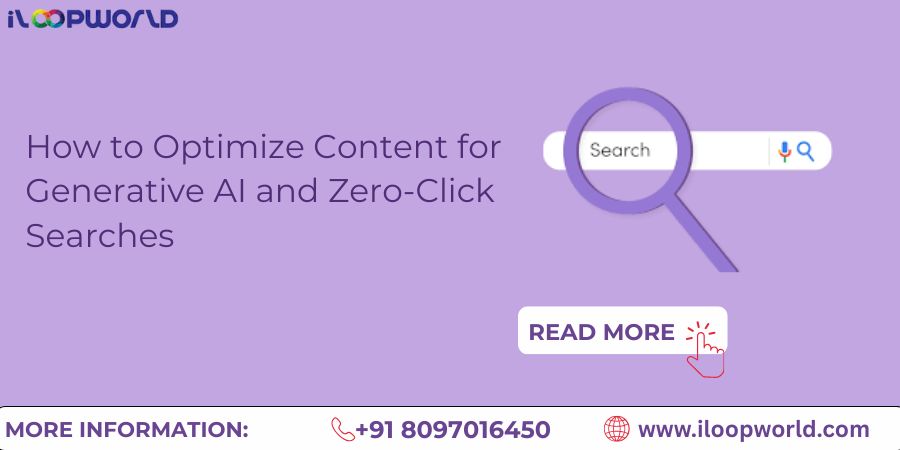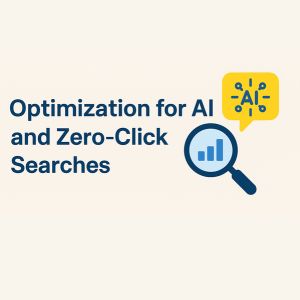How to Optimize Content for Generative AI and Zero-Click Searches

In today’s fast-evolving digital landscape, search engines are no longer just about ranking pages — they’re becoming answer engines. With the rise of generative AI and zero-click searches, brands need to rethink how they create and structure content. Traditional SEO alone won’t cut it anymore; you must learn how to optimize content for generative AI to stay visible in an AI-driven world.
This guide will walk you through everything you need to know — from understanding how AI-driven SEO works to creating content that thrives in zero-click searches and conversational AI experiences.
What Is Generative AI and How It Impacts Search
Generative AI refers to artificial intelligence systems — like ChatGPT, Gemini, or Claude — that can generate human-like answers and summaries from vast sources of information. In search, these systems don’t just list links; they provide AI-generated answers directly within search results.
That means your audience might get what they need without ever clicking your website — a phenomenon called zero-click searches.To survive this new search model, brands must optimize content for generative AI so it can still surface as a trusted source in AI-generated answers, summaries, and chat responses.
Understanding Zero-Click Searches
A zero-click search happens when users find the information they need directly on the search engine results page (SERP) — without visiting any website. Examples include:
- Featured snippets
- Knowledge panels
- “People also ask” boxes
- AI-generated summaries
With Google’s AI Overviews and Bing’s Copilot search, zero-click behavior is increasing. While this may sound like a threat, it’s also an opportunity to ensure your brand appears in AI-driven responses — not just traditional rankings. By applying AI-driven SEO and modern content optimization techniques, you can make your content more discoverable to both users and algorithms.
Why Traditional SEO Is No Longer Enough
Traditional SEO focused heavily on keywords, backlinks, and metadata. But AI search systems analyze far more than that — including context, tone, relationships between entities, and semantic meaning.
Now, AI content optimization means:
- Writing for context and clarity, not keyword density
- Using structured data so AI systems understand your content
- Building topic authority with interconnected pages
If you want your content to stand out, you need to optimize content for generative AI using principles of natural language processing (NLP) and semantic SEO.
How to Optimize Content for Generative AI
Here’s a practical breakdown of how to align your content with AI search systems and zero-click formats.
Focus on Search Intent and Context
Generative AI doesn’t just match keywords — it interprets search intent. When you optimize content for generative AI, focus on context-rich answers and human-centered clarity. To align with that:
- Analyze what users really want (informational, navigational, transactional).
- Structure answers clearly and concisely.
- Use headings that reflect natural questions (“What,” “How,” “Why”).
Create Conversational and Structured Content
Since AI models deliver results in a conversational tone, your content should mirror that. This makes your pages more eligible for AI Overviews and zero-click visibility.
Use:
- Conversational search phrases like “how to,” “best way to,” “what is.”
- Short paragraphs and lists for easier summarization.
- Schema markup (FAQ, HowTo, Article) so search engines understand your structure.
Use NLP Optimization and Schema Markup
NLP optimization helps AI systems understand the meaning behind your words. This ensures your content is machine-readable and human-friendly — the foundation of AI-driven SEO. Best practices include:
- Using synonyms and related phrases (semantic SEO).
- Applying schema tags for products, FAQs, or articles.
- Incorporating AI search visibility tools like Google’s Rich Results Test.
Strengthen Topical Authority
NLP optimization helps AI systems understand the meaning behind your words. This ensures your content is machine-readable and human-friendly — the foundation of AI-driven SEO. Best practices include:
- Using synonyms and related phrases (semantic SEO).
- Applying schema tags for products, FAQs, or articles.
- Incorporating AI search visibility tools like Google’s Rich Results Test.
Building a Content Strategy for AI Search
Your content strategy for AI search should go beyond traditional keyword lists. Here’s how to structure it for long-term success.
Step 1: Identify Conversational Queries
People now ask questions directly (“What’s the best AI SEO strategy?”).
Use tools like AnswerThePublic or AlsoAsked to find conversational search queries.
Step 2: Optimize for Zero-Click Searches
By learning how to optimize content for zero-click searches, your brand can secure visibility in AI snippets even without clicks. Design your content for immediate answers:
- Start with summaries
- Use bullet points and tables
- Include FAQs and definitions
Step 3: Integrate Multimedia and Context
AI models read images, videos, and alt text. This multi-format strategy enhances AI search visibility and boosts engagement. Add:
- Infographics
- Transcribed videos
- Structured headings
Tracking and Measuring AI Search Visibility
Traditional metrics like CTR and rankings don’t tell the full story anymore. If your brand consistently appears in AI-generated results, it means your AI-driven SEO efforts are working. To measure success in the AI era:
- Track featured snippet frequency
- Monitor brand mentions in AI summaries
- Use tools like Google Search Console Insights and Bing Webmaster Tools
- Analyze zero-click impressions in reports
Future of AI-Driven SEO
As search evolves, AI content optimization will dominate the next generation of SEO. Expect the following trends:
- Voice and conversational search to grow
- Personalized AI assistants to deliver tailored answers
- Entity-based SEO to replace traditional keyword ranking
- AI models referencing high-authority sites only
The takeaway?
To stay ahead, brands must continuously optimize content for generative AI, adapt to NLP optimization, and embrace semantic search strategies.

Visual Optimization for AI and Zero-Click Searches
AI search engines don’t just read text—they analyze images, videos, and other media. Optimizing visuals ensures your content is eligible for AI-generated summaries and zero-click results.
Image SEO Best Practices:
- Alt Text: Use descriptive, context-rich alt text that includes relevant keywords naturally. Example: Alt=”Generative AI SEO strategy infographic by iloopworld”
- Captions: Add captions explaining the content of images for both humans and AI.
- File Names: Use descriptive names (generative-ai-zero-click.jpg) instead of generic ones (IMG1234.jpg).
- AI Recognition: Ensure charts, infographics, or diagrams clearly convey concepts for AI parsing.
Video & Infographic Optimization:
- Include transcripts or captions so AI can understand spoken content.
- Use structured video schema (VideoObject) for better indexing.
- Add summaries or highlights to make videos eligible for snippet display in AI search results
Common Mistakes to Avoid in AI-Driven SEO
Optimizing for AI search is different from traditional SEO. Avoid these common pitfalls:
- Over-Optimization & Keyword Stuffing: AI systems prioritize context and semantic meaning over exact keyword repetition. Focus on clarity and natural phrasing.
- Ignoring Contextual & Conversational Signals: Don’t just match keywords—understand user intent and provide complete, context-rich answers.
- Neglecting Structured Data: Without schema markup, AI may not correctly interpret your content structure, reducing eligibility for featured snippets.
- Weak Topical Authority: Single, isolated pages are less likely to be trusted by AI. Build clusters with internal linking and authoritative references.
- Neglecting Multimedia Content: Ignoring images, videos, and charts reduces your visibility in AI-powered summaries, which increasingly incorporate multimedia.
Conclusion
The world of search is shifting from blue links to intelligent answers.
By learning how to optimize content for generative AI and zero-click searches, your brand can maintain visibility even when users never leave the SERP.
Focus on:
- Conversational, context-rich content
- Schema and NLP optimization
- Strong topical authority and structured data
The brands that adapt early will dominate AI-driven SEO in the years ahead. If you’re ready to future-proof your website, start optimizing today with experts like iloopworld.com/digital-marketing-services — your partner in AI-ready SEO growth.
Frequently Asked Question
1. What does it mean to optimize content for generative AI?
It means structuring and writing content so AI systems can easily understand, summarize, and display it in AI-generated search results.
2. How can I rank in zero-click searches?
Use structured data, concise summaries, and clear question-based headings. This helps your content appear in featured snippets and AI responses.
3. Why is AI-driven SEO important?
Because search engines now use AI to generate contextual answers instead of just listing links. AI-driven SEO ensures your content remains visible in this new environment.
4. How do I use NLP optimization for SEO?
Incorporate natural phrasing, related entities, and context-driven keywords. NLP optimization helps AI understand meaning beyond keywords.
5. What’s the best content strategy for AI search?
Build topic clusters, use conversational search phrases, and focus on semantic depth. This approach strengthens your content strategy for AI search.